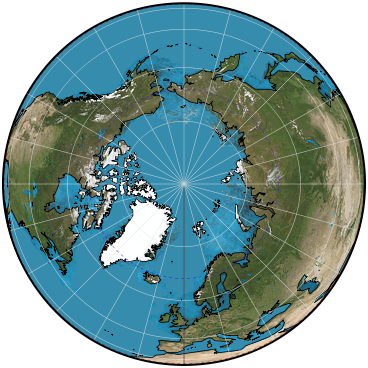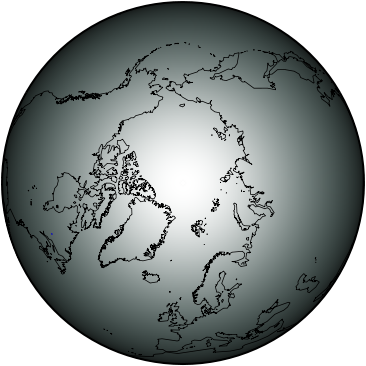Classifications
azimuthal
perspective
Graticule
Polar aspect:.
Meridians: Equally spaced straight lines intersecting at the central pole. Angles between them are the true angles.
Parallels: Unequally spaced circles centered at the pole, which is a point. If the usual perspective from above the surface is projected, the spacing of parallels decreases away from the pole, and the equator cannot be shown. If point of perspective is beneath the surface, the spacing may increase or decrease away from the pole, and part of the opposite hemisphere can be shown.
Symmetry: About any meridian.
Equatorial aspect:.
Meridians: Central meridian is a straight line. Other meridians are generally unequally spaced elliptical arcs intersecting at the poles (which may not be visible).
Parallels: Equator is a straight line. Other parallels are usually elliptical arcs. If point of perspective is beneath the surface, the parallels can be elliptical, parabolic, or hyperbolic arcs.
Symmetry: About the central meridian or the equator.
Oblique aspect:.
Meridians: Central meridian is a straight line. Other meridians are generally unequally spaced elliptical arcs intersecting at each pole.
Parallels: One parallel, normally nearer the pole than is the center of projection, depending on the position of the point of perspective, is a straight line. Other parallels are normally elliptical arcs.
Symmetry: About the central meridian.
Range
If point of perspective is above the surface, less than one hemisphere If point of perspective is on the opposite side of the Earth's center, more than one hemisphere.
Limiting forms
Gnomonic projection, if the point of perspective is at the center of the Earth.
Stereographic projection, if the point of perspective is on the surface of the Earth opposite the center of projection.
Orthographic projection, if the point of perspective is at infinity.
In turn, the Vertical Perspective is a limiting form of the Tilted Perspective projection.
Scale
True at the center, if the projection is onto a tangent plane. Scale varies away from the center, depending on the point of perspective.
Distortion
Only the center is free of distortion, if projection is onto a tangent plane. Distortion is severe near the outer limit of the projection, although special locations for the points of projection on the opposite side of the Earth's center result in moderate distortion within a wide range of the center.
Special features
The General Vertical Perspective projection shows the Earth geometrically as it appears from any point above or below the surface when it is projected onto a tangent or secant plane perpendicular to the straight line connecting the point of perspective with the center of the Earth.
Usage
Pictorial views of the Earth, resembling those seen from space.
Specializations
In 1701, Philippe de la Hire of France suggested a point of projection at 1.7071 times the radius. This distance is measured from the center in a direction away from the surface of projection and gives the equator of the polar aspect twice the radius of 45° latitude.
Antoine Parent in 1702, Ernst Hammer about 1890, H.F. Gretschel in 1873, and Hans Maurer in 1935 were among others proposing points of projection for low-error perspectives.
A.R. Clarke and Henry James, in 1862 and later, calculated points of projection (on the far side, below the surface of projection) for minimum-error perspective azimuthal projections of regions, such as continents, bounded by a given great or small circle on the Earth.
The Army Map Service AMS Lunar projection is a far-side perspective selected by Albert L. Nowicki in 1963 to show slightly more than a hemisphere of the Moon, as seen over a period of time from the Earth. The point of projection is 1.53748 times the radius from the center.
See also the Airy nonperspective azimuthal projection.
Origin
Aside from the earlier limiting forms listed below, the perspective projection from a point on the opposite side of the Earth's center was studied in the 18th and 19th centuries as a source of low-distortion projections having geometric construction.
 Cylindric
Cylindric Pseudocylindric
Pseudocylindric Conic
Conic Azimuthal
Azimuthal Lenticular
Lenticular Miscellaneous
Miscellaneous

